Papers by Kyriakos Kachrimanis
Journal of Thermal Analysis and Calorimetry, 2013
Thermal analysis is an essential, analytic tool used in preliminary studies and preparation of ne... more Thermal analysis is an essential, analytic tool used in preliminary studies and preparation of new pharmaceutical formulations. This study was performed to investigate the possible interactions between trandolapril and three commonly used natural excipients, namely alactose monohydrate, microcrystalline cellulose, and pregelatinized starch. The compatibility studies were carried out using thermoanalytic along with other complementary techniques. Differential scanning calorimetry and thermogravimetric analysis have proved that trandolapril is fully compatible with all the studied excipients until 100°C. The complementary techniques used in this study were X-ray powder diffraction, Fourier transform-infrared spectroscopy, and scanning electron microscopy which confirmed the findings of thermal analysis.

Nanomedicine Nanotechnology Biology and Medicine, 2014
Zeolite particles with different pore diameter and particle size were loaded with the model antic... more Zeolite particles with different pore diameter and particle size were loaded with the model anticancer drug 5-fluorouracil. The loaded zeolites were characterized by means of SEM, XRD, DSC, XPS, N2 physisorption and FT-IR. Higher loading of 5-FU was observed for NaX-FAU than BEA. Release studies were carried out in HCl 0.1N. Release of 5-FU from NaX-FAU showed exponential-type behaviour with the drug fully released within 10 min. In the case of BEA, the kinetics of 5-FU shows a multi-step profile with prolonged release over time. Molecular dynamics simulations showed that diffusion of the drug molecule through the BEA framework is lower than for NaX-FAU due to increased van der Waals interaction between the drug and the framework. The effect of zeolitic particles on the viability of Caco-2 monolayers showed that the NaX-FAU particles cause a reduction of cell viability in a more pronounced way compared with the BEA particles. This article describes zeolite-based nanoparticles in generating time-controlled release of 5-FU from zeolite preparations for anti-cancer therapy.
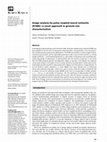
Journal of Pharmacy and Pharmacology, 2007
A biologically inspired spiking neural network model, the pulse coupled neural network (PCNN), ha... more A biologically inspired spiking neural network model, the pulse coupled neural network (PCNN), has been applied for the first time in bulk particle characterization, and specifically in the characterization of pharmaceutical granule size distributions. The PCNN was trained on surface images of pharmaceutical granule beds, and the adjustable parameters (radius neuron interconnection, r 0 , linking weight coefficient, b, local threshold potential, V Θ , and number of iterations) were successfully optimized using design of experiments. As demonstrated with size fractions of granules, it was found that the PCNN produced granule size-dependent signals. In general, a first highest and relatively narrow peak located in the region of two to twelve iterations corresponded to smaller particle size, while larger particles resulted in wider peaks and in highest (not first) peak at a range between 13 and 25 iterations. Better predictions, i.e. lower RMSEP (root mean squared error of prediction) values, were obtained using high b value, low r 0 and V Θ values, while the number of iterations had to exceed 110 and the optimized model (RMSEP lower than 5) corresponded to PCNN variables: r 0 = 1, b = 0.4, V Θ = 2, and number of iterations = 150. The coefficient of determination (R 2 ) of the model was 0.94 and the predicted variation (Q 2 ) was 0.91, while the Pearson correlation coefficient between the predicted and the measured mean particle size by sieving for eight test batches was 0.98. These findings could be characterized as promising and encouraging for the further use of image analysis by PCNNs in pharmaceutical bulk particle size and shape characterization.

European Journal of Pharmaceutical Sciences, 2015
In this study binary carbamazepine-hydroxypropyl-β-cyclodextrin, as well as ternary carbamazepine... more In this study binary carbamazepine-hydroxypropyl-β-cyclodextrin, as well as ternary carbamazepine-hydroxypropyl-β-cyclodextrin-hydrophilic polymer systems were used to improve dissolution rate of carbamazepine. It has been shown that addition of hydrophilic polymers (Soluplus(®) and two types of hydroxypropyl methylcellulose-Metolose(®) 90SH-100 and Metolose(®) 65SH-1500) significantly increased solubilization capacity of hydroxypropyl-β-cyclodextrin for carbamazepine. Evaluation of carbamazepine-hydroxypropyl-β-cyclodextrin-hydrophilic polymer interactions using molecular modeling techniques showed interactions between carbamazepine, which dissociates from inclusion complexes and hydroxypropyl methylcellulose that can prevent crystallization of dissolved carbamazepine. These results can contribute to better understanding of drug-cyclodextrin-hydrophilic polymer interactions which are still not well understood. After evaluation of carbamazepine solubilization with hydroxypropyl-β-cyclodextrin and hydrophilic polymers, both binary carbamazepine-hydroxypropyl-β-cyclodextrin and ternary carbamazepine-hydroxypropyl-β-cyclodextrin-hydrophilic polymer systems were prepared by spray drying. The results of solid state characterization methods showed amorphous nature of carbamazepine in all spray dried systems, which together with the results of molecular modeling techniques indicates inclusion complex formation. Carbamazepine dissolution rate was significantly improved from spray dried formulations compared to pure drug. Binary carbamazepine-hydroxypropyl-β-cyclodextrin and ternary carbamazepine-hydroxypropyl-β-cyclodextrin-Soluplus(®) systems exhibited the fastest carbamazepine release, wherein the entire amount of carbamazepine was released during first 5 min.

Journal of pharmaceutical and biomedical analysis, 2014
One of the most challenging aims in modern analytical chemistry and pharmaceutical analysis is to... more One of the most challenging aims in modern analytical chemistry and pharmaceutical analysis is to create models for drugs' behavior based on simulation experiments. Since drugs' effects are closely related to their molecular properties, numerous characteristics of drugs are used in order to acquire a model of passive absorption and transfer in the human body. Importantly, such direction in innovative bioanalytical methodologies is also of stressful need in the area of personalized medicine to implement nanotechnological and genomics advancements. Simulation experiments were carried out by examining and interpreting the chromatographic behavior of 113 analytes/drugs (400 observations) in RP-HPLC. The dataset employed for this purpose included 73 descriptors which are referring to the physicochemical properties of the mobile phase mixture in different proportions, the physicochemical properties of the analytes and the structural characteristics of their molecules. A series of ...
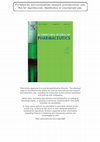
International journal of pharmaceutics, Jan 15, 2012
The present study investigates the possibility of using poloxamers as solubility and dissolution ... more The present study investigates the possibility of using poloxamers as solubility and dissolution rate enhancing agents of the poorly water soluble drug substance desloratadine that can be used for the preparation of immediate release tablet formulation. Two commercially available poloxamer grades (poloxamer P 188 and poloxamer P 407) were selected, and solid dispersions (SDs) containing different weight ratio of poloxamers and desloratadine were prepared by a low temperature melting method. All SDs were subjected to basic physicochemical characterization by thermal and vibrational spectroscopy methods in order to evaluate the efficiency of poloxamers as solubility enhancers. Immediate release tablets were prepared by direct compression of powdered solid dispersions according to a General Factorial Design, in order to evaluate the statistical significance of two formulation (X(1) - type of poloxamer in SD and X(2) - poloxamer ratio in SD) and one process variable (X(3) - compression ...

Pharmaceutical Development and Technology, 2015
This study investigates the potential of poloxamers as solid dispersions (SDs) carriers in improv... more This study investigates the potential of poloxamers as solid dispersions (SDs) carriers in improving the dissolution rate of a poorly soluble drug, carbamazepine (CBZ). Solid dispersions were prepared with poloxamer 188 (P188) and poloxamer 407 (P407) by melting method in different drug:carrier ratios (1:1, 1:2 and 1:3). Prepared samples were characterized using differential scanning calorimetry (DSC), hot-stage polarized light microscopy (HSM), powder X-ray diffraction (PXRD) and Fourier transform infrared spectroscopy (FT-IR) to investigate drug physical state within the SDs matrix, possible polymorphic transitions and drug-polymer interactions. The interactions between CBZ molecules and polymeric chains were also evaluated using molecular dynamics simulation (MDS) technique. The most thermodynamically stable polymorphic form III of CBZ was present in all SDs, regardless of the type of poloxamer and drug-to-carrier ratio. The absence of drug-polymer interactions was observed by FT-IR analysis and additionally confirmed by MDS. Formation of persistent hydrogen bond between two CBZ molecules, observed by MDS indicate high tendency of CBZ molecules to aggregate and form crystalline phase within dispersion. P188 exhibit higher efficiency in increasing CBZ dissolution rate due to its more pronounced hydrophilic properties, while increasing poloxamers concentration resulted in decreasing drug release rate, as a consequence of their thermoreversible gelation.

Pharmaceutical Research, 2008
At high relative humidity (RH), orthorhombic paracetamol (form II) crystallized from ethanol tran... more At high relative humidity (RH), orthorhombic paracetamol (form II) crystallized from ethanol transforms to monoclinic (form I) faster than such crystallized from the melt. The present study attempts to elucidate the reasons for this difference in stability. The transformation of form II was investigated by powder X-ray diffraction, optical microscopy, gravimetric moisture sorption, thermogravimetry, and vibrational spectroscopy. Solution-grown form II was found to be always contaminated with form I nuclei but still transforms much faster than corresponding physical mixtures of the pure forms in high RH, at a rate that is depending on the RH and the size of the crystals. A 0.1-0.6% w/w mass loss, inversely related to the initial monoclinic content, was observed during transformation of solution-grown form II, and was found to be due to residual ethanol that could not be removed by grinding, indicating incorporation by a solid solution mechanism. Moisture triggers the growth of existing form I nuclei but it exerts a weaker effect on nucleation, and the presence of residual ethanol greatly accelerates the transformation.

Nanomedicine: Nanotechnology, Biology and Medicine, 2014
Zeolite particles with different pore diameter and particle size were loaded with the model antic... more Zeolite particles with different pore diameter and particle size were loaded with the model anticancer drug 5-fluorouracil. The loaded zeolites were characterized by means of SEM, XRD, DSC, XPS, N2 physisorption and FT-IR. Higher loading of 5-FU was observed for NaX-FAU than BEA. Release studies were carried out in HCl 0.1N. Release of 5-FU from NaX-FAU showed exponential-type behaviour with the drug fully released within 10 min. In the case of BEA, the kinetics of 5-FU shows a multi-step profile with prolonged release over time. Molecular dynamics simulations showed that diffusion of the drug molecule through the BEA framework is lower than for NaX-FAU due to increased van der Waals interaction between the drug and the framework. The effect of zeolitic particles on the viability of Caco-2 monolayers showed that the NaX-FAU particles cause a reduction of cell viability in a more pronounced way compared with the BEA particles. This article describes zeolite-based nanoparticles in generating time-controlled release of 5-FU from zeolite preparations for anti-cancer therapy.
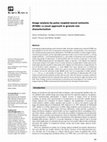
Journal of Pharmacy and Pharmacology, 2007
A biologically inspired spiking neural network model, the pulse coupled neural network (PCNN), ha... more A biologically inspired spiking neural network model, the pulse coupled neural network (PCNN), has been applied for the first time in bulk particle characterization, and specifically in the characterization of pharmaceutical granule size distributions. The PCNN was trained on surface images of pharmaceutical granule beds, and the adjustable parameters (radius neuron interconnection, r 0 , linking weight coefficient, b, local threshold potential, V Θ , and number of iterations) were successfully optimized using design of experiments. As demonstrated with size fractions of granules, it was found that the PCNN produced granule size-dependent signals. In general, a first highest and relatively narrow peak located in the region of two to twelve iterations corresponded to smaller particle size, while larger particles resulted in wider peaks and in highest (not first) peak at a range between 13 and 25 iterations. Better predictions, i.e. lower RMSEP (root mean squared error of prediction) values, were obtained using high b value, low r 0 and V Θ values, while the number of iterations had to exceed 110 and the optimized model (RMSEP lower than 5) corresponded to PCNN variables: r 0 = 1, b = 0.4, V Θ = 2, and number of iterations = 150. The coefficient of determination (R 2 ) of the model was 0.94 and the predicted variation (Q 2 ) was 0.91, while the Pearson correlation coefficient between the predicted and the measured mean particle size by sieving for eight test batches was 0.98. These findings could be characterized as promising and encouraging for the further use of image analysis by PCNNs in pharmaceutical bulk particle size and shape characterization.
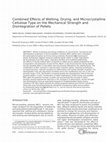
Journal of Pharmaceutical Sciences, 2009
Effects of wetting and drying conditions on micromeritic, mechanical and disintegration propertie... more Effects of wetting and drying conditions on micromeritic, mechanical and disintegration properties of microcrystalline cellulose (MCC) pellets were evaluated. Extrusion/spheronization and three drying methods (fluidized bed, microwaves, and freeze drying) were applied using two wetting liquids (water or water-isopropanol 60:40 w/w) and three MCC types: (standard, silicified, and modified). Additionally, the effects of drying method were compared on highly porous pellets prepared by the incorporation and extraction of pore former (NaCl). It was found that the drying method has the greatest effect on the pellet size and porosity followed by the wetting liquid. The modification of MCC resulted in reduced water retention ability, implying hornification, increased porosity, reduced resistance to deformation and tensile strength of pellets. The disintegration time also decreased markedly due to the modification but only in the low porosity range <37%. Silicification increased greatly the disintegration time of the low porosity pellets (<14%). Combination of water-isopropanol, freeze drying and modified MCC gave the greatest increase in pellet size and porosity. The increase in pellet porosity caused exponential reduction in the resistance to deformation, tensile strength and disintegration time, as expected. Compared to fluidized bed, the freeze drying resulted in 20-30% higher porosity for pellets prepared without pore former and 6% for those with pore former, indicating the possibility of preparing highly porous pellets by employing freeze drying.
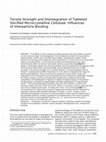
Journal of Pharmaceutical Sciences, 2003
The effects of some material variables (particle size and moisture content) on the tensile streng... more The effects of some material variables (particle size and moisture content) on the tensile strength and disintegration time of tableted standard microcrystalline cellulose (MCC, Avicel 1 ) and a silicified brand (SMCC, Prosolv 1 ) were studied. Three particle size fractions were employed, after equilibration in three levels of environmental relative humidity (RH%), and the tensile strength and disintegration time were determined at different levels of total tablet porosity or packing fraction (p f ). The MCC grade or silicification affects the moisture sorption and the packing during tapping as well as the particle deformation (yield pressure, P y ) during tableting. There was a slight increase in the tensile strength but a marked increase in the disintegration time of Prosolv 1 compared with Avicel 1 in the p f range 0.7-0.9, which corresponds the range for pharmaceutical tablets. These increases are explained in terms of the range and magnitude of the interparticle forces developed and the interparticle separation. Despite the higher moisture content of Prosolv 1 after equilibration compared with Avicel 1 , compression of Prosolv 1 results in higher P y , in tablets of higher energy of interparticle bonding, longer interparticle separation, and extended disintegration compared with Avicel 1 . The incorporated SiO 2 is thought to play the role of barrier or sink for the moisture sorbed, but only for RH up to 52%, which is a moisture content range less than twice that of tightly bound water. At higher RH (72%), the incorporated SiO 2 does not increase the P y , but reduces the energy of interparticle bonding and the interparticle separation because of its probable saturation. The latter, in turn, results in more extended disintegration times due to reduced uptake of water into the tablets and to the probable reduction of water available for the deployment of the microcrystalline cellulose activity as disintegrant. ß
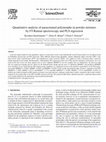
Journal of Pharmaceutical and Biomedical Analysis, 2007
A fast and simple method for the quantitative analysis of monoclinic (form I) and orthorhombic (f... more A fast and simple method for the quantitative analysis of monoclinic (form I) and orthorhombic (form II) paracetamol was developed, based on FT-Raman spectroscopy and PLS regression. Three different preprocessing algorithms, namely orthogonal signal correction (OSC), standard normal variate transformation (SNV) and multiplicative scatter correction (MSC), were applied in order to eliminate effects caused by sample preparation and sample inhomogeneities. Subsequently, PLS regression models were fitted and their predictive performance was evaluated on the basis of the root mean squared error of cross-validation (RMSECV) over the complete data set. Furthermore, the data were split into two equal-sized training and test subsets by the Kennard-Stone design and the errors of calibration (RMSEC) and prediction (RMSEP) were calculated. It was found that the OSC preprocessing contributes to a significant increase in the predictive performance of the PLS regression model (RMSECV = 0.500%, RMSEC = 0.842% and RMSEP = 0.538%) in the overall concentration range of form I, compared to the SNV (RMSECV = 2.398%, RMSEC = 0.911% and RMSEP = 7.177%) and MSC (RMSECV = 2.7648%, RMSEC = 1.572% and RMSEP = 4.838%). In addition, the model developed on OSC preprocessed data is more parsimonious, requiring a single latent variable, compared to three latent variables required by the models fitted to the SNV and MSC preprocessed data. The proposed multivariate calibration presents a significant improvement over existing methods for the quantitation of paracetamol polymorphs.
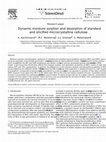
European Journal of Pharmaceutics and Biopharmaceutics, 2006
Moisture sorption and desorption isotherms of standard and silicified microcrystalline cellulose ... more Moisture sorption and desorption isotherms of standard and silicified microcrystalline cellulose (MCC and SMCC) were determined using an automatic multi-sample gravimetric analyzer, and compared by fitting different kinetic models, including the excess surface work model (ESW), the BET and GAB model, Young and Nelson model and recently developed parallel exponential kinetics (PEK) model. It was found that silicification affects the moisture sorption and desorption properties of SMCC mainly at high relative humidity (above 50% and 70%, respectively). In general, the differences in the moisture sorption and desorption properties of MCC and SMCC can be elucidated by the different kinetic models. Particularly the PEK model shows that hysteresis is related primarily to a fast sorption process, which corresponds to bound water, and secondarily to a slow process, which corresponds to sorption of free water and that SMCC acquires more water than MCC at RH higher than 50% by the slow (secondary) sorption process. A possible mechanism for this process is presumably the hydrolysis of SiO2 particles and formation of silanol groups that act as a water reservoir, preventing the accumulation of more water in the polymer matrix and thus may be protecting the structure of SMCC from undergoing irreversible structural changes that would impair its performance as an excipient.
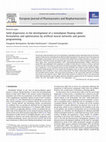
European Journal of Pharmaceutics and Biopharmaceutics, 2011
The present study investigates the use of nimodipine-polyethylene glycol solid dispersions for th... more The present study investigates the use of nimodipine-polyethylene glycol solid dispersions for the development of effervescent controlled release floating tablet formulations. The physical state of the dispersed nimodipine in the polymer matrix was characterized by differential scanning calorimetry, powder X-ray diffraction, FT-IR spectroscopy and polarized light microscopy, and the mixture proportions of polyethylene glycol (PEG), polyvinyl-pyrrolidone (PVP), hydroxypropylmethylcellulose (HPMC), effervescent agents (EFF) and nimodipine were optimized in relation to drug release (% release at 60 min, and time at which the 90% of the drug was dissolved) and floating properties (tablet's floating strength and duration), employing a 25-run D-optimal mixture design combined with artificial neural networks (ANNs) and genetic programming (GP). It was found that nimodipine exists as mod I microcrystals in the solid dispersions and is stable for at least a three-month period. The tablets showed good floating properties and controlled release profiles, with drug release proceeding via the concomitant operation of swelling and erosion of the polymer matrix. ANNs and GP both proved to be efficient tools in the optimization of the tablet formulation, and the global optimum formulation suggested by the GP equations consisted of PEG = 9%, PVP = 30%, HPMC = 36%, EFF = 11%, nimodipine = 14%. Ó

European Journal of Pharmaceutical Sciences, 2004
The effects of compact size and of powder particle size on the determination of "apparent" compre... more The effects of compact size and of powder particle size on the determination of "apparent" compressive Young's modulus of elasticity, E, were evaluated, for three pharmaceutical excipients (Microcrystalline cellulose, MCC, Calcium hydrogen phosphate dihydrate, CHPD, and pregelatinized starch, PGS) differing in deformational behaviour during compression. One-and two-compact (composite) specimens were employed and the equations of Spriggs [J. Am. Ceram. Soc. 44 (1961) 628] and Phani & Niyogi [J. Mater. Sci. 22 (1987) 257] were employed for prediction of E, at zero and 0.15 porosity (E 0 and E 0.15 ). It was found that E 0 and E 0.15 are affected by the particle size, in the case of PGS, but by the compact size and assembly in the case of MCC and CHPD. Reduction in E 0 and E 0.15 values for two-compact assembly corresponded to large and medium compact size only of MCC and CHPD, while specimen assembly was not affecting significantly the experimental data if small compacts of MCC and CHPD or any size compacts of PGS were used. The exponent f of the Phani and Niyogi equation has been considered as parameter of pore structure and particle morphology. It was significantly affected by the compact size of all the excipients, by the two-compact assembly of MCC and CHPD and by the particle size of CHPD and PGS. Absence of significant particle size effect on the parameter f, for the case of MCC is attributed to the elongated particle shape, while the highly significant one for the case of PGS is explained by the extensive elasto-plastic deformation during compression, which is greatly dependent on the grain size. Values of the % radial elastic recovery (%RR), at porosity 0 and 0.15, were determined and correlation of the experimental data was attempted to Young's modulus (E). A simple linear equation is proposed for prediction of Young's modulus, E, from %RR, at least in the porosity range between 0.1 and 0.3 (representative of commercial pharmaceutical tablets), but use of %RR instead to E is applicable only under many limitations.

European Journal of Pharmaceutical Sciences, 2005
The effects of compact size and powder particle size on the axial compressive (sigma(C)) and diam... more The effects of compact size and powder particle size on the axial compressive (sigma(C)) and diametral tensile (sigma(T)) strength were evaluated, for three compressed pharmaceutical diluents (microcrystalline cellulose, MCC, calcium hydrogen phosphate dihydrate, CHPD, and pregelatinized starch, PGS) differing in deformational behaviour during compaction and testing. Cylindrical specimens of similar aspect ratio ( approximately 1) but different diameter (13, 10 and 5mm) and total porosity (0.35-0.05) were employed and the extrapolated and interpolated strength values, at zero and 0.15 porosity (sigma(C0) or sigma(T0) and sigma(C0.15) or sigma(T0.15)), were predicted by applying an exponential relation. The ratio of sigma(C0.15)/sigma(T0.15) was correlated to the corresponding percent radial elastic recovery (%RR). It was found that the changes of compressive and tensile strength with compact size were not characteristic and general. Specimen's size affected both extrapolated and interpolated values of sigma(C) and sigma(T) most significantly in the case of MCC, for which sigma(T) increased while sigma(C) decreased, as the compact size became smaller. Less significant was the effect of compact size on the interpolated value of compressive strength (sigma(C)) and the extrapolated value of tensile strength (sigma(T)) for PGS. For CHPD, no significant and characteristic effect of compact size was observed. Particle size significantly affected the interpolated values of sigma(T) for MCC and both sigma(C) and sigma(T) for CHPD; they all increased with decreasing particle size. The sigma(C0.15)/sigma(T0.15) ratio was affected significantly by the compact size only in the case of MCC and seems to be an indication of material elasto-plasticity, since PGS has by far the highest ratio, followed by MCC and CHPD. A correlation between sigma(C0.15)/sigma(T0.15) and %RR was established as was its dependence upon deformational behaviour.

Drug Development and Industrial Pharmacy, 2013
This study investigates the solid-solid interactions between nimodipine (NIM) and polyethylene gl... more This study investigates the solid-solid interactions between nimodipine (NIM) and polyethylene glycol (PEG) of different mean molecular weights (PEG 2000, 4000 and 6000), in solid dispersion systems, applying differential scanning calorimetry (DSC), Fourier-Transform infrared spectroscopy, powder X-ray diffraction (PXRD), hot stage microscopy (HSM) and theoretical modeling by the Flory-Huggins (FH) solution theory. Phase diagrams constructed with the aid of DSC and FH solution theory showed sensitivity on the estimated values of the FH interaction parameter (χ). When χ is considered a constant number (χ = α, α ≠ 0), formation of a eutectic mixture is predicted in the 70-80% w/w PEG concentration region, while when χ was considered as a function of concentration and temperature (χ = f(φ,Τ)), the model predicts the formation of monotectic systems. Construction of more precise phase diagrams by HSM to the aid of Kofler's "contact preparation" method confirmed the monotectic nature of the examined systems. Studies on NIM's re-crystallization process in the solid dispersions revealed a strong dependence of the crystallization rate, as well as the resulting crystal form, on the mean molecular weight and concentration of PEG: NIM crystallization rates decrease as PEG's MW increases, while NIM mod II crystals predominate in dispersions prepared at temperatures above NIM's liquidus and growth of NIM mod I prevailing in PEG-rich samples.
Chemical Engineering Research and Design, 2014
Please cite this article in press as: Djokić, M., et al., The influence of spiral jet-milling on ... more Please cite this article in press as: Djokić, M., et al., The influence of spiral jet-milling on the physicochemical properties of carbamazepine form III crystals: Quality by design approach. Chem. Eng. Res. Des. (2013), http://dx.
Cited By (since 1996):5, Export Date: 6 June 2013, Source: Scopus, Language of Original Document:... more Cited By (since 1996):5, Export Date: 6 June 2013, Source: Scopus, Language of Original Document: English, Correspondence Address: Malamataris, S.; Dept. of Pharmaceutical Technology, School of Pharmacy, University of Thessaloniki, Thessaloniki 54006, Greece, References: Inseln, P.P.A., Analgesic-antipyretics and anti-inflammatory agents (1990), pp. 665-666. , Goodman and Gilman's The Pharmacological Basis of Therapeutics, A.G. Gilman, T.W. Rall, A.S. Nies and P. Taylor Eds., 8th ed., Pergamon Press, New YorkKawashima, Y., Niwa, T., Handa, T., Takeuchi, H., Iwamoto, T., Itoh, Y., Preparation of prolonged-release spherical micro-matrix of ibuprofen with acrylic polymer by the emulsion-solvent diffusion method for improving bioavailability (1989) Chem. Pharm. Bull., 37 (2), pp. 425-429;

Uploads
Papers by Kyriakos Kachrimanis